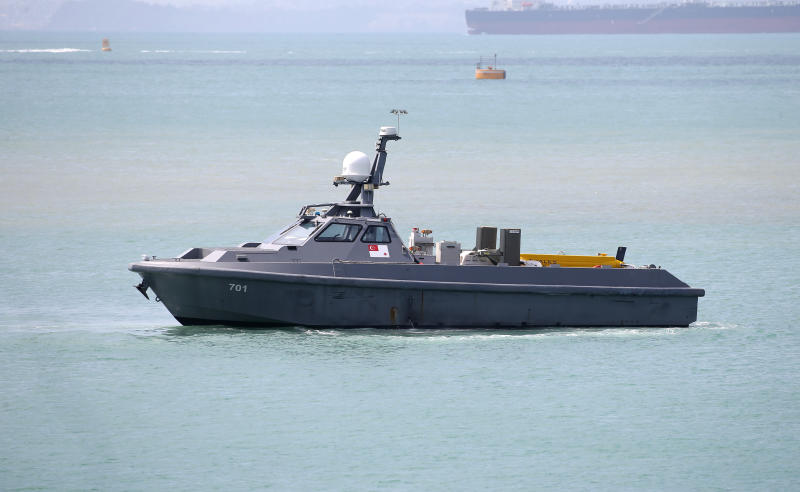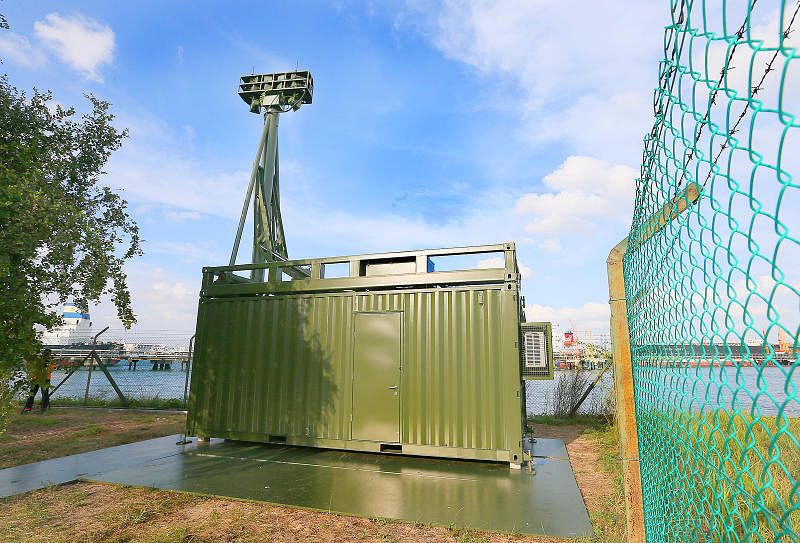Mighty tech: SAF innovates with unmanned ships, drones and watch towers
Sign up now: Get ST's newsletters delivered to your inbox

The unmanned surface vessel (USV) takes about six minutes to deploy sonar equipment, with two operators controlling the ship remotely.
ST PHOTO: SEAH KWANG PENG
Follow topic:
SINGAPORE - Drones, autonomous vessels and unmanned watch towers are some of the technology that the Singapore Armed Forces has invested in to tackle the manpower crunch and improve operational efficiency. This was shared by Defence Minister Ng Eng Hen during the debate last Friday (March 2) on his ministry's spending plans for the year. The Straits Times looks at some of these innovations, one each from the air force, army and navy.
Faster detection of sea mines with unmanned surface vessel
The process of detecting and disposing of sea mines can be significantly faster in the future when a new unmanned ship, currently on trial, goes into operation.
The unmanned surface vessel (USV) takes about six minutes to deploy sonar equipment, with two operators controlling the ship remotely. It currently takes the Bedok-class Mine Countermeasure Vessel (MCMV), which is operated by a crew of about 30 men, about 45 minutes to perform the same task.
With a modular design, the USV carries a towed synthetic aperture sonar system and can also be configured to carry out coastal patrols in the future.
The Mine Countermeasure USV - which was designed and built locally and is now in the final stages of a year-long trial - has an automatic launch and recovery system.
The Republic of Singapore Navy currently has two of these USVs, each weighing 30 tonnes, measuring about 16m in length and capable of travelling at a speed of more than 25 knots.
Designed for high speed and manoeuvrability, the USVs can also navigate safely and operate autonomously when close to other vessels, as it is equipped with a built-in collision detection and avoidance system.
Such patrols are currently done by 30-man patrol vessels or 23-man Littoral Mission Vessels. A coastal patrol USV can be operated remotely by just two men.
Major Lim Yoong Seet, 38, the officer commanding for Unmanned Underwater Systems, said the process of detection and disposal of mines can now be more seamless, as a USV fitted with a disposal system can take over the task of disposal right after, while a single MCMV has a recovery downtime.
"Once the MCM USV is done with detecting and classifying mines, it can seamlessly hand over the information to the USV with the mine disposal system for mine identification and neutralisation," he added.
Military Expert 2 Briane Vivaegananthan, 36, a USV payload supervisor whose job includes maintaining and operating the USVs, said: "In terms of operational effectiveness, we can meet the objectives in a much faster way. With the current USV, we can hit a maximum speed of more than 25 knots, compared to the MCMV, which was about 15 knots. That's almost two times the speed."
Other than the USVs, the navy is also testing a Smart Base Access project that will reduce the number of security personnel required and could generate savings of $160,000 per year at Changi Naval Base. A trial for this project started last month.
Drones part of "smart" airbases
In the Republic of Singapore Air Force's (RSAF) vision of "smart" airbases of the future, drones might take over the checking of runways for damage or be deployed to capture errant drones using a net.
Aircraft turnaround time and aircraft engineer workload could be reduced with an automated aircraft inspection system. Maintenance tasks could be more proactive when data analytics is applied to aircraft information, such that works could be carried out before more complex problems surface.
Military Expert 5 Tommy Ong, 35, head of airbase operability systems at the Air Plans Department, said: "The airbase is an intricate and tightly connected war-fighting system. The RSAF is developing 'smart' airbases to generate and sustain air power for the RSAF more effectively.
"Leveraging technologies such as data analytics and artificial intelligence will also revolutionise the way we fight, and enable us to be more effective, agile and resilient in air power generation operations."
Since January, the air force has been testing out drones to carry out damage assessment for runways, such as detecting potholes or craters. Equipped with electro-optical, infrared and lidar (light detection and ranging) sensors, these drones can be used during both the day and night.
Currently, checking for runway damage is done manually through visual inspections.
The system will prioritise runway repair operations and recommend taxi routes to minimise disruption to aircraft launch and recovery operations. Current algorithms can help it to detect objects as small as a canned drink.
This and other initiatives will be gradually rolled out when they are ready, as trials are still ongoing for these systems.
On realising the "smart" airbase vision, ME5 Ong said that algorithm development remains one of the main challenges.
"We understand that it's not possible to have a 100 per cent working algorithm at the outset, so we want to in-build some kind of learning mechanism in this algorithm, to aid in its development. So over time, it'll be more robust."
Tower keeps close watch on Singapore waters
A new watch tower with advanced sensor systems deployed at Jurong Island means Singapore Armed Forces soldiers on surveillance duty no longer need to look out to sea using binoculars for hours.
Surveillance can now be done remotely, reducing the number of soldiers required for such operations by up to 30 per cent.
When intruders come within Singapore's waters, an alert will be sent through automated target identification. The tower also provides a better field of view and range than what can be seen with the naked eye, even during night-time.
The first Unmanned Watch Tower (UWT) is already operational this month, with two more to be deployed on Jurong Island by September.

Calling the watch tower "an important addition that strengthens the overall defence of Jurong Island", Colonel Dinesh Vasu Dash, 44, Commander of 2nd People's Defence Force (2 PDF), said that the most impressive thing about the system is not its eyes, but its brain.
"In the system, data analytics and pattern matching are used to alert the operator to any anomalies, following which the operator is able to do a more detailed investigation. He's then able to trigger quick response forces from both the SAF or the Singapore Police Force."
Designed and built by the DSO National Laboratories, the 6m-tall structure can be deployed on demand to enhance the SAF's surveillance capability for protection of installation operations.
Compared to soldiers watching the waters using binoculars, the UWT has twice the area of coverage and better view in low-light conditions such as during night-time, although Defence Ministry declined to reveal the range of the tower due to operational security concerns.
Such information collected will be shared with other agencies, such as the Police Coast Guard, to enhance coordination efforts in coastal surveillance.
The UWT is also equipped with a long-range acoustic device, which operators can use to warn off intruders once they enter a certain restricted zone close to Singapore.
Corporal James Tan, 24, a security trooper currently deployed on Jurong Island, said the main difficulty he faces is eye fatigue from staring at the sea for prolonged periods.
"Having the UWT gives us good visuals, with clear and precise accuracy of the vessels that are coming in, so that we can react quickly."

